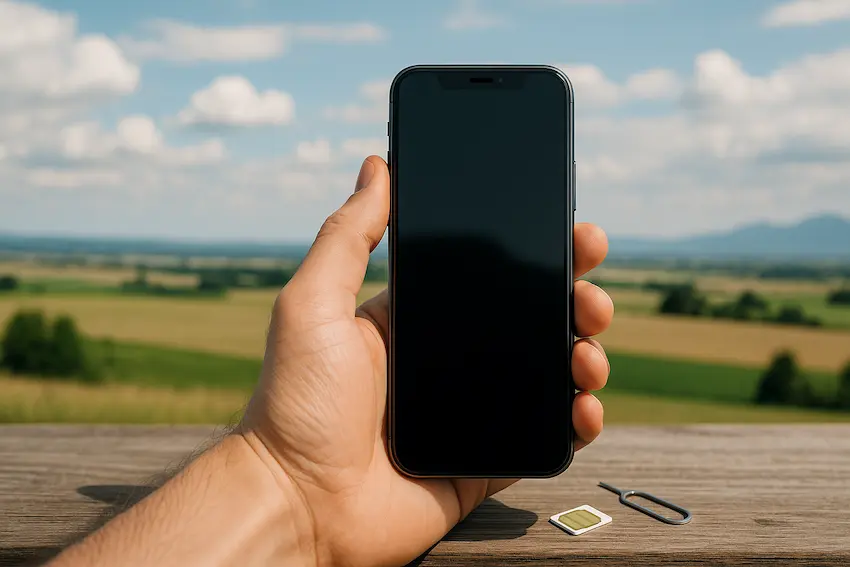How to Check if Your Phone is Unlocked and eSIM Compatible

Planning to switch carriers or grab a cheap eSIM plan? Before you buy, check two things: whether your phone is unlocked and whether it supports eSIM. This guide walks you through both in plain English, with quick checks for iPhone and Android.
Quick Summary
- Unlocked phone means you can use any SIM or eSIM from any carrier, anywhere in the world
- iPhone unlock check: Settings, General, About, Carrier Lock. Look for No SIM restrictions
- Android unlock check: Try a different SIM or look in Network settings for carrier selection options
- eSIM check: Look for “Add eSIM” or “Add Cellular Plan” in your phone settings
Part 1: What Unlocked Means and Why It Matters
An unlocked phone isn’t tied to one mobile carrier. Pop in a physical SIM from any company, or install an eSIM plan from any provider and it’ll work. A locked phone only accepts SIMs and eSIMs from the carrier that sold it, until you get it unlocked.
Real numbers on why this matters:
- Travel eSIM in Japan: $13.99 for 10GB
- Your home carrier roaming in Japan: $10/day = $200 for 20 days
- You save $186 by using an unlocked phone with a travel eSIM
When your phone is unlocked, you can:
- Use local data plans when you travel (way cheaper than roaming)
- Switch carriers anytime to chase better deals
- Avoid paying your home carrier’s international roaming fees
If your phone is locked, contact the carrier that sold it. In most countries, carriers will unlock your device once the contract is finished or the device is paid off. Some carriers (like US carriers) have online unlock request forms that process in 24 – 48 hours.
Part 2: How to Check if Your Phone Is Unlocked
For iPhone
- Open Settings.
- Tap General then About.
- Scroll to Carrier Lock.
- If it says No SIM restrictions, the iPhone is unlocked.
- If it says SIM locked or similar, it is still tied to a carrier.
Optional quick test: borrow a SIM from a friend on another network. If it connects and you can make a call or use data, your phone is unlocked.
For Android
Android menus vary by manufacturer, so use whichever method works for your model.
Option 1: Try a different SIM
Insert a SIM from another carrier and restart. If the phone connects, it is unlocked. If you see an error like SIM not supported, it is likely locked.
Option 2: Check network settings
Go to Settings, then Connections or Network & Internet, then Mobile Networks or Network Operators. If you can select networks manually, that is a sign it may be unlocked.
If you bought the phone on a contract, check with the carrier to confirm unlock rules.
Part 3: What an eSIM Is and Why You Might Want One
An eSIM is a digital SIM already built into your phone with no physical card to swap. Instead of going to a shop, you buy a plan online, scan a QR code or tap “Install” in an app, and boom, you’re connected. The whole process takes about 3 minutes.
Why we love eSIMs:
- Instant activation: Buy on the plane, install at the airport WiFi, connected before you leave baggage claim
- Keep your home number active: Use your physical SIM for calls and texts, eSIM for data – no more missing 2FA codes
- Multiple plans on one device: This week in France, next week in Spain, just switch eSIM plans in settings
- No tiny plastic cards to lose: Ever dropped a nano SIM in an airport? We have, we don’t recommend it.
Not every phone or region supports eSIM, so always check before you buy a plan.
Part 4: How to Check if Your Phone Supports eSIM
iPhone eSIM check
- Open Settings.
- Tap Cellular or Mobile Data.
- Look for Add eSIM or Add Cellular Plan. If you see that option your iPhone supports eSIM.
General compatibility notes:
- Models from iPhone XR, XS, XS Max and newer usually support eSIM.
- iPhone 14 and newer sold in the U.S. are eSIM only, with no physical SIM tray.
- Older phones like iPhone 8 and earlier do not support eSIM.
Android eSIM check
- Open Settings.
- Go to Network & Internet or Connections then SIMs or SIM manager.
- Look for an option that says Add eSIM.
Common Android models that often support eSIM:
- Google Pixel 3 and newer.
- Samsung Galaxy S20 and newer, Note20, Z Flip and Z Fold series.
- OnePlus 11 and newer in some regions.
- Motorola Edge+ 2020 and newer.
- Select Xiaomi models like 12T Pro and 13 series depending on region.
If your model is not obvious, search the exact model name plus eSIM support to confirm.
Part 5: Regional Differences and Why They Matter
Some phones include eSIM hardware but it is disabled in certain markets. A phone from one country might have more features than the same model sold in another country. Always check the region code or ask the seller about eSIM support before you buy.
Part 6: Dual SIM, eSIM, and Physical SIM Explained
Most eSIM capable devices let you run two lines at once: one physical SIM plus one eSIM. This setup is perfect for travel.
How people actually use this:
- Physical SIM: Home number (for calls, texts, 2FA codes from your bank)
- eSIM: Local travel data plan (cheap data, no roaming fees)
In your phone settings, you choose which line handles mobile data (set to your travel eSIM) and which line handles calls (set to your home number, or use WiFi calling). This way you stay reachable on your home number while using local data rates.
Newer phones (like iPhone 13 and up) can store multiple eSIM profiles and even run two eSIMs simultaneously if there’s no physical SIM installed.
Part 7: What to Do if Your Phone Is Locked or Not eSIM Ready
If it is locked:
- Contact the carrier that sold the phone. They often provide an unlock code or send instructions after the contract ends.
- If you bought the phone secondhand, ask the seller for proof it was unlocked or request an unlock through the carrier.
If it is not eSIM ready:
- Use a physical SIM while you travel.
- Consider upgrading to an unlocked, eSIM compatible phone when convenient. Many mid range phones now include eSIM support.
Part 8: Quick eSIM Activation Test
Want to be sure everything works? Use a small trial eSIM.
- Choose a provider that offers a small or free trial plan.
- Scan the QR code or follow the provider app install instructions.
- If the profile installs and data works, your phone is eSIM ready.
If something fails, reboot the phone and make sure you’re on Wi-Fi (not mobile data) during installation. Most providers can resend the QR code or issue a new one through chat support.
FAQs
Can I use an eSIM if my phone is locked?
No. If the phone is locked to a carrier it will generally not accept eSIMs from other providers until it is unlocked.
Why won’t my eSIM activate?
Possible reasons: poor internet connection when installing, a corrupted QR code, or a carrier restriction. Contact the eSIM provider for a fresh activation link.
Will deleting an eSIM delete my phone data?
No. Deleting an eSIM removes that mobile profile only. Your apps and files remain intact.
Can I have two eSIMs simultaneously?
Some phones let you store multiple eSIM profiles but only certain combinations let two be active at once. Check your phone model documentation.
Key Discounts
Final Thoughts
Checking unlock status and eSIM compatibility takes a couple of minutes and saves you a lot of hassle later. Once you know the phone is ready, you can pick a plan that matches your trip or daily needs and use our verified coupon codes to save.

